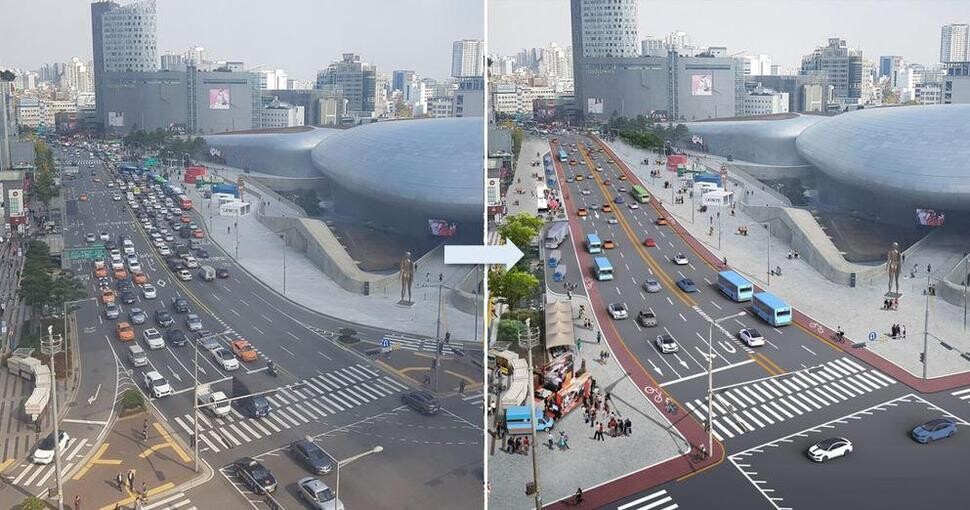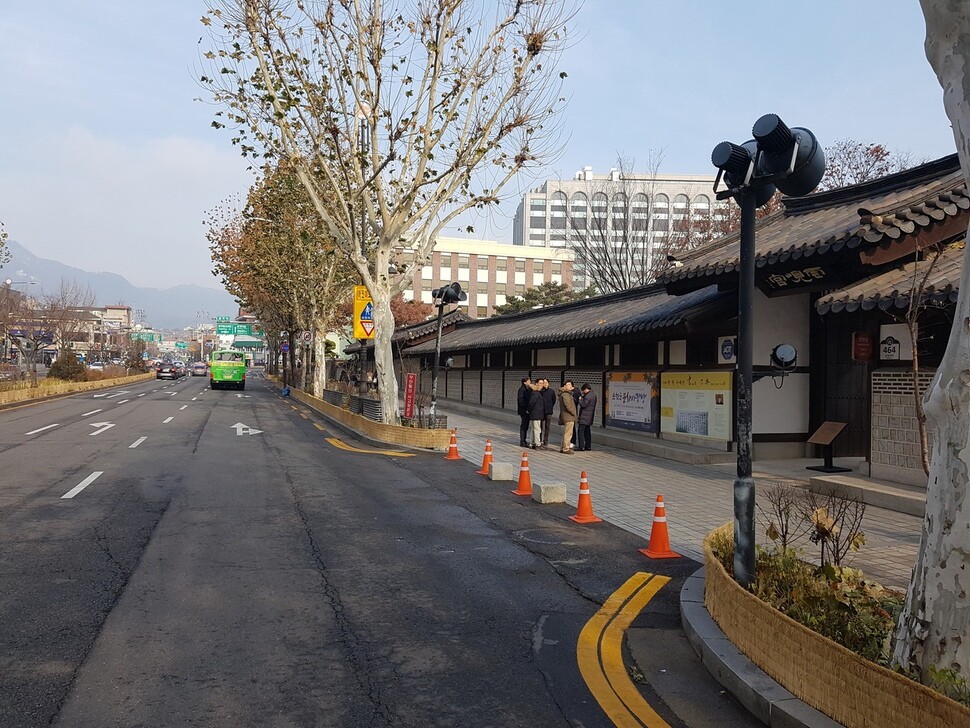hankyoreh
Links to other country sites 다른 나라 사이트 링크
Seoul roads to be changed to encourage bike and pedestrian traffic in city center

All roads within Seoul’s four major gates are to be narrowed to between four to six total lanes, starting with Sejong Road, Eulji Road, and Toegye Road this year. But the city of Seoul has left other policy measures to drastically improve transportation and the environment within the gates as mid- to long-term projects, including implementation of congestion tolls and even- and odd-numbered vehicle days.
The city announced on Mar. 5 that it had submitted a draft of “special comprehensive green transportation promotion zone measures” to the Ministry of Land, Infrastructure and Transport (MOLIT). The green transportation promotion zone is a policy effort to promote environmentally friendly transportation. In Mar. 2017, 16.7 square kilometers of Seoul within the four main gates (Hanyang Fortress Walls) were designated by MOLIT as a green transportation promotion zone. The city plans to go ahead with its measures once they are approved by the ministry.
As part of the measures, the city is to reduce all roads to within the four gates to a total of four to six lanes. A maximum of six lanes will be allowed for roads with large amounts of bus traffic or dedicated bus lanes, while other roads will be restricted to up to four lanes. Additional lanes from the reduced roads are to be used as bicycle and pedestrian paths or for work-related temporary parking for loading and unloading. In 2017, the city created a bike lane with the building of a central bus lane on Jongno Road.
The project is set to begin this year with Sejong Road, Eulji Road, and Toegye Road. The reduction of the 1,500-meter stretch of Sejong Road between Gwanghwamun Junction and Seoul Station, which currently reaches ten lanes at its widest, is to be tied to the restructuring of Gwanghwamun Square, while the efforts for Eulji Road (3,700 meters from Seoul City Hall to Dongdaemun History and Culture Park, maximum of eight lanes) and Toegye Road (1,200 meters from Taegye Road No. 1 to 5, maximum of eight lanes) are to be respectively linked to renewal of the Seun Sangga shopping area and Namsan’s Yejang Jarak neighborhood.
The Sejong Road project is seen as the most central in terms of symbolism and traffic volumes, with the approach to restructuring Gwanghwamun Square poised to be a key factor. The current plan for the square, which involves building roads underground while using the entire ground-level space for the square, has faced considerable opposition on cost-related and environmental grounds.
The project will also result in slower traffic speeds within the four gates. Speed limits are to be lowered to 50 km/hr for main roads and 30 km/hr for inside roads, with additional safety infrastructure installed to reduce speeds.


Vehicle demand is to be reduced through an environmental rating system. Once the Ministry of Environment’s environmental rating system is decided upon this year, vehicle number recognition systems are to be put in place at 43 points of entry to the green transportation zone to police the entry of vehicles with low ratings. Department stores and supermarkets are to be held increasingly responsible for traffic volume with annual increases in traffic generation surcharges through 2020. But the city opted not to adopt forceful and efficient transportation and fine particle dust improvement measures such as an even- and odd-numbered vehicle day system or congestion tolls, citing the potential burden on citizens and related objections.
Pedestrian and bike paths are also to be expanded. The city of Seoul plans to designate “special pedestrian zones” this year in Seochon, the Eulji Road area, and other neighborhoods and extend zone status to the entire area within the four gates. Crosswalks are to be installed at all intersections within the gates by 2030.
Additional policies aim to increase the use of public transportation. By 2030, currently separated bus lanes are to be connected on Sejong Road (1,700 meters from Sungryemun to Gwanghwamun), Namdaemun Road (1,350 meters from Namdaemun to Jongno 1-ga), and Tongil Road (600 meters from the National Police Agency to Seoul Station. City and village bus stops are to be integrated to address inconveniences caused by their separation for passengers transferring between them.
Electric buses are to be introduced as an environmentally friendly means of transportation, starting with 30 in 2018 before being expanded to 3,000 by 2025. Electric vehicles are to account for 100% of shared vehicles within the four gates by 2020.
Criticism that the policy is a defensive measure aimed at avoiding controversy
“The optimal approach is to reduce vehicle volumes through a ‘road diet’ policy,” explained Kim Sang-cheol, a policy committee member with Public Transportation Net
“It’s unfortunate that they’ve abandoned effective approaches to demand management such as an even- and odd-number vehicle day system and congestion tolls within the four gates,” Kim added.
“During the Seoul mayoral election campaign, they need to compete with new policy agendas, and it looks as though the city is coming out with defensive measures as a way of avoiding controversy.”
By Kim Kyu-won, staff reporter
Please direct questions or comments to [english@hani.co.kr]

Editorial・opinion
![[Column] Park Geun-hye déjà vu in Yoon Suk-yeol [Column] Park Geun-hye déjà vu in Yoon Suk-yeol](https://flexible.img.hani.co.kr/flexible/normal/500/300/imgdb/original/2024/0424/651713945113788.jpg) [Column] Park Geun-hye déjà vu in Yoon Suk-yeol
[Column] Park Geun-hye déjà vu in Yoon Suk-yeol![[Editorial] New weight of N. Korea’s nuclear threats makes dialogue all the more urgent [Editorial] New weight of N. Korea’s nuclear threats makes dialogue all the more urgent](https://flexible.img.hani.co.kr/flexible/normal/500/300/imgdb/original/2024/0424/7317139454662664.jpg) [Editorial] New weight of N. Korea’s nuclear threats makes dialogue all the more urgent
[Editorial] New weight of N. Korea’s nuclear threats makes dialogue all the more urgent- [Guest essay] The real reason Korea’s new right wants to dub Rhee a founding father
- [Column] ‘Choson’: Is it time we start referring to N. Korea in its own terms?
- [Editorial] Japan’s rewriting of history with Korea has gone too far
- [Column] The president’s questionable capacity for dialogue
- [Column] Are chaebol firms just pizza pies for families to divvy up as they please?
- [Column] Has Korea, too, crossed the Rubicon on China?
- [Correspondent’s column] In Japan’s alliance with US, echoes of its past alliances with UK
- [Editorial] Does Yoon think the Korean public is wrong?
Most viewed articles
- 1‘We must say no’: Seoul defense chief on Korean, USFK involvement in hypothetical Taiwan crisis
- 2N. Korean delegation’s trip to Iran shows how Pyongyang is leveraging ties with Moscow
- 3Amnesty notes ‘erosion’ of freedom of expression in Korea in annual human rights report
- 4[Column] Park Geun-hye déjà vu in Yoon Suk-yeol
- 5‘Weddingflation’ breaks the bank for Korean couples-to-be
- 6[Reportage] On US campuses, student risk arrest as they call for divestment from Israel
- 7[Editorial] New weight of N. Korea’s nuclear threats makes dialogue all the more urgent
- 8Why Korea shouldn’t welcome Japan’s newly beefed up defense cooperation with US
- 9[Guest essay] The real reason Korea’s new right wants to dub Rhee a founding father
- 10Will NewJeans end up collateral damage in internal feud at K-pop juggernaut Hybe?